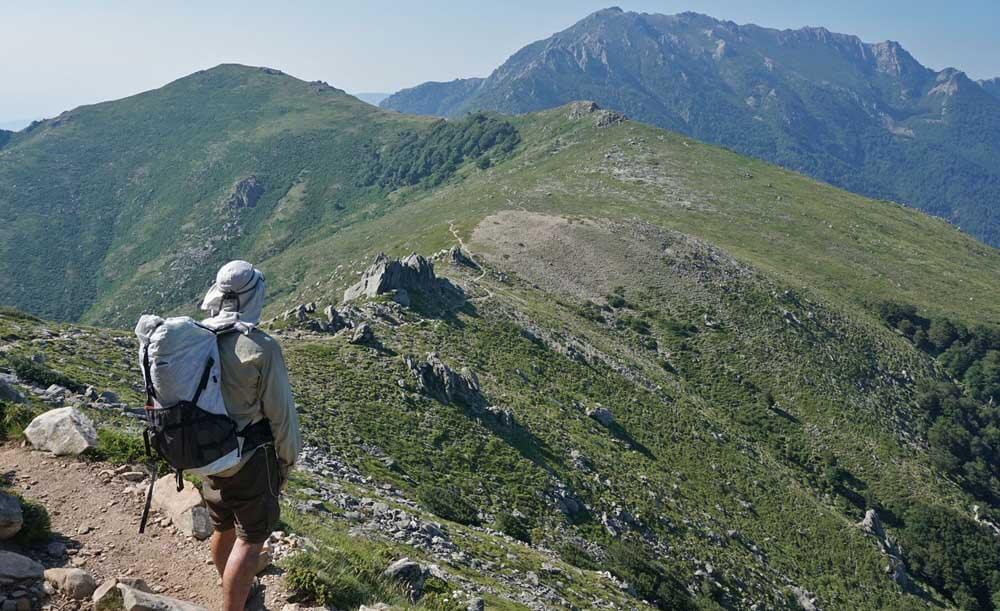
Moving fast and light along the spectacular ridge line of the GR20 in Corsica. A minimal pack (and good pre-trip training) enabled Alison and I to do a 16 day trip in under 8 days. Pictured – the award winning Hyperlite Mountain Gear 2400 Southwest Pack
You make Adventure Alan & Co possible. When purchasing through links on our site, we may earn an affiliate commission at no additional cost to you. Here’s why you can trust us.
Quick ways to reduce backpack weight. A few may surprise you…
- Look at The Big Three: Backpack, Tent/shelter, and Sleep System (sleeping bag, sleeping pad, and ground cloth). You stand to lose a bunch of weight from these: as much as 10 to 12 pounds.
- Take a Backpack that weighs less than two pounds. See our: Best Backpacks for Backpacking and Hiking
- Take a Tent that weighs less than two pounds. See our: Best Backpacking Tents | Lightweight & Ultralight
- Take a Sleeping bag that that weighs less than 1.5 pounds. See our: Buyers Guide to Lightweight Backpacking Quilts & Sleeping Bags
- Look at our 9 Pound Full Comfort Lightweight Backpacking Gear List for more ideas for gear to save weight.
Nine pounds of backpacking gear is all a hiker needs to be safe and warm. Or simply put, this list has better backpacking gear. For over a decade it’s been tested, refined, and updated to reflect only the best and most current backpacking gear now available in 2019. So, if you want to reduce pack weight without reducing comfort, look no further! The hiking gear in this guide is suitable for all 3-season conditions on trips around the world, from Alaska, to Patagonia, to Utah.
- Look on The Backpacking Food Page to save a ton of weight at zero cost
- Get a weather report (the NOAA hourly weather graph is among the most informative and accurate)—then pack for those conditions! Since 90% of backpackers take 90% their trips for 3 days or or less, this weather report should be quite accurate for the short time you are out. This will let you pack a tent, clothing, and sleeping bag appropriate for actual conditions. It will also deter you from taking inappropriate, “what-if-the-worst-happens!” gear, e.g. 6 pound tent, and a +10F sleeping bag for a balmy weather trip on the Appalachian Trail.
- Don’t take extra clothing. e.g. don’t take any more clothing than you can wear at one time.
- Take less: Be disciplined and leave a few items at home that you haven’t used in the last three trips. Put stuff like sunscreen and trail soap in smaller containers.
- Extra Credit: Browse The Gear Lists Page for other ideas and examples to save weight. This will give you a good examples of what type of gear is available and what is a reasonable weight for that type of gear, e.g. around 6-8 ounces for a rain jacket, or around 1.0 ounce for a pocket knife. Think hard if your gear is 2 to 3x heavier than the examples on these lists.
- Read my The Best Hydration — Drink When Thirsty. Use a Sawyer Squeeze Water Filter to drink at the source (lake, stream, etc.). Then only carry a sensible amount to get to your next known water source. I.e. it makes no sense to carry 3 liters of water, almost 7 pounds, when your next water source is only two hours away.
- Remember to have fun! That will at least, lighten your spirit and mood.
How Do I Start?
- Ground yourself in reality: Get all your stuff together and weigh it. If you’re like most conventional hikers, your equipment will weigh around 30 pounds, possibly higher.
- Get individual weights for your heavier items like tents and backpacks. For stuff in the range of a few pounds or less you’ll want to buy an inexpensive digital scale that weighs up to 10 pounds.
- See what you can leave at home. Anything you don’t bring is free weight reduction. Think hard about this one. Do you really need it?
- Put together a spreadsheet (or at least a list) with all your equipment weights. This is an indispensable analysis tool.
- Try to figure out where you’ll get the most “bang for the buck.” e.g. figure out how much a new item costs and divide that by the amount of weight it will save you over your old equipment. Target the items that give you the most weight loss for the fewest dollars.
- Buy on Sale: Don’t try to purchase all your new equipment right away. Many items regularly go on sale or are closed out. Watch carefully over the course of a year and you could save 30 to 70 percent on your equipment.
